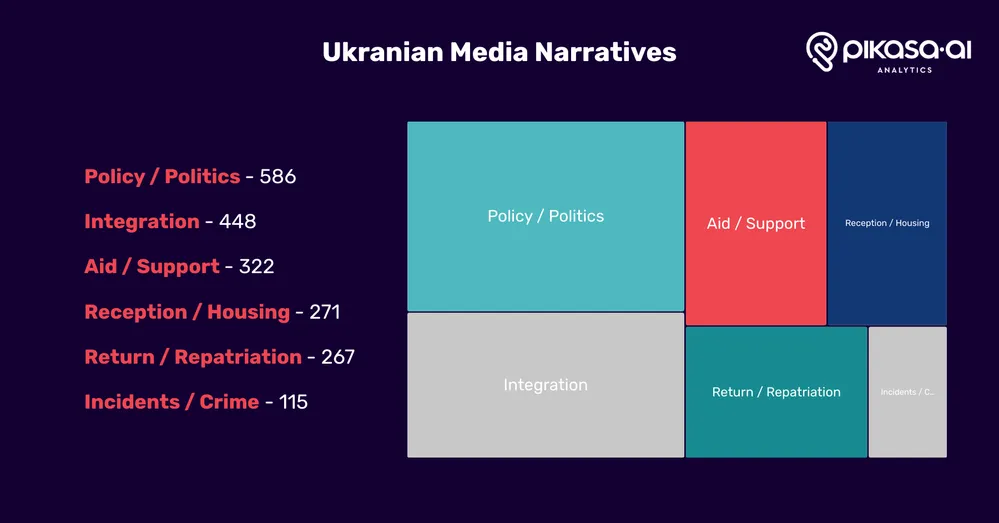Ukrainian Refugee Narratives: 7 Powerful Insights from Pikasa Analytics
Pikasa Analytics’ January - March 2025 media monitoring reveals how Ukrainian outlets frame refugee narratives across Europe. Tracking over 1,000 media sources with the Analytics.live platform, the study found that refugees remain a steady media priority, with coverage focusing on policy debates, integration successes, and resilience stories in Poland, Germany, Czechia, and beyond. While disinformation exists on the fringes, mainstream reporting emphasizes solidarity, adaptation, and long-term integration, showing that displaced Ukrainians are visible, valued, and supported both abroad and at home.
As the war in Ukraine enters another year, millions of Ukrainians remain displaced across Europe. But how are their stories told back home?
Between January and March 2025, Pikasa Analytics conducted an in-depth study using its advanced Analytics.live monitoring platform. The analysis tracked over 1,000 media sources, from traditional outlets to social networks, to uncover the tone, themes, and narratives surrounding Ukrainian refugees in the EU.
The findings reveal not only what is being reported, but also how refugees are framed and why these narratives matter for both Ukraine and its European partners.
Here are 7 powerful insights shaping the conversation:
1. Refugee Stories Remain a Steady Media Priority
Coverage of Ukrainian refugees did not fade after the initial crisis. From January to March 2025, Ukrainian outlets produced hundreds of refugee-related posts every month, showing that displaced citizens remain a constant focus in national discourse.
This steady attention contrasts with the typical media cycle, where crises often fade after initial headlines. Instead, Ukrainian refugees remain at the heart of public conversation.
2. Poland, Germany, and Czechia Lead the Narrative
Unsurprisingly, coverage centered on the countries hosting the largest Ukrainian communities.
- Poland appeared most frequently, reflecting its role as both a destination and a transit hub.
- Germany and Czechia followed closely, tied to significant refugee populations and active integration policies.
- Interestingly, the UK, though outside the EU, also featured prominently due to its “Homes for Ukraine” program.
This focus mirrors real-world migration patterns and highlights where Ukrainian media attention aligns with refugee realities.

3. Policy and Politics Dominate Refugee Narratives
The single most reported theme was policy and politics, with over 586 articles covering government decisions that shaped refugee conditions.
Stories included:
- EU-level debates on temporary protection status.
- National decisions on benefits, housing rules, and welfare cuts.
- Discussions on refugee rights within host parliaments.
By focusing heavily on policy, Ukrainian media ensured its audience stayed informed on how official decisions impact daily life for refugees abroad.

4. Integration Stories Gain Visibility
A major portion of coverage celebrated how Ukrainians were adapting to life abroad. Reports highlighted:
- Language courses and education programs for children.
- Employment success stories, where refugees filled labor shortages in host countries.
- Cultural centers and community hubs, preserving traditions while easing integration.
These narratives framed refugees not just as victims of war, but as resilient individuals rebuilding their lives.
5. Tone: Neutral, Positive, and Realistic
The overall tone of Ukrainian media coverage was largely neutral to positive with respect to the refugees. The sentiment was classified as: Positive, Negative, or Neutral, based on whether the narrative cast refugees and their situation in a favorable/supportive light, an unfavorable/problematic light, or simply reported facts without strong connotations. Importantly, “negative” did not equate to hostility. Instead, these articles highlighted systemic challenges, not blaming refugees themselves. This nuance reflects Ukrainian media’s empathetic stance toward its displaced citizens.
6. Disinformation Exists but Remains on the Fringes
Mainstream Ukrainian media relied on credible sources like the UN, EU institutions, and host government officials. However, fringe outlets sometimes amplified hostile narratives, including:
- Claims that Europe is “abandoning” Ukrainian refugees.
- Sensationalism around benefit cuts.
- Propaganda-style language portraying refugees as burdens.
Analysis showed these narratives were isolated, not mainstream, and often bore hallmarks of Russian disinformation. Thanks to responsible journalism, their impact was limited.
7. From Crisis to Long-Term Integration
One of the most striking findings was how narratives evolved over time:
- January: Coverage focused on winter hardships and migration statistics.
- February: Stories reflected on the war anniversary and the question of return.
- March: Narratives shifted toward long-term integration - schools, jobs, cultural programs, and housing stability.
This progression signals that displacement is no longer seen as a temporary emergency, but a long-term challenge and opportunity. Refugees are increasingly framed as future contributors to both host countries and Ukraine itself.
Conclusion
The Pikasa Analytics study, powered by the Analytics.live platform, provides a rare and detailed look at how Ukrainian media portrays refugees in the EU.
The 7 insights reveal a story of resilience, adaptation, and solidarity:
- Refugees remain a central topic.
- Narratives highlight both challenges and successes.
- Disinformation exists but is largely contained.
Ultimately, Ukrainian media reinforces the idea that refugees are not forgotten, they are our people, representing Ukraine abroad while building lives in Europe.
As integration deepens, these narratives will continue to shape public perception, ensuring that displaced Ukrainians remain visible, valued, and supported.
Written by
Natasha Dimova
September 17, 2025